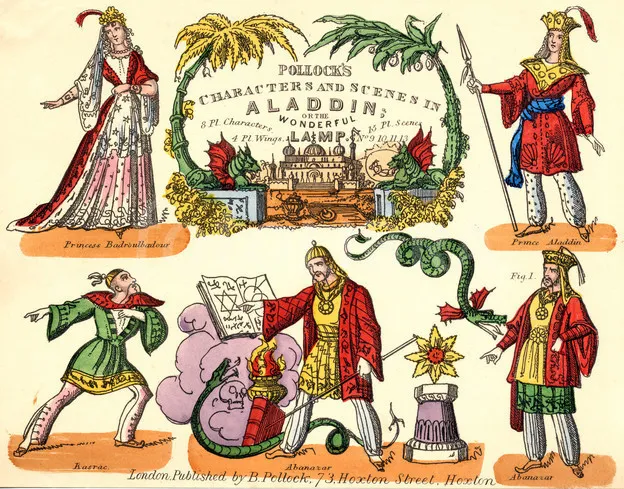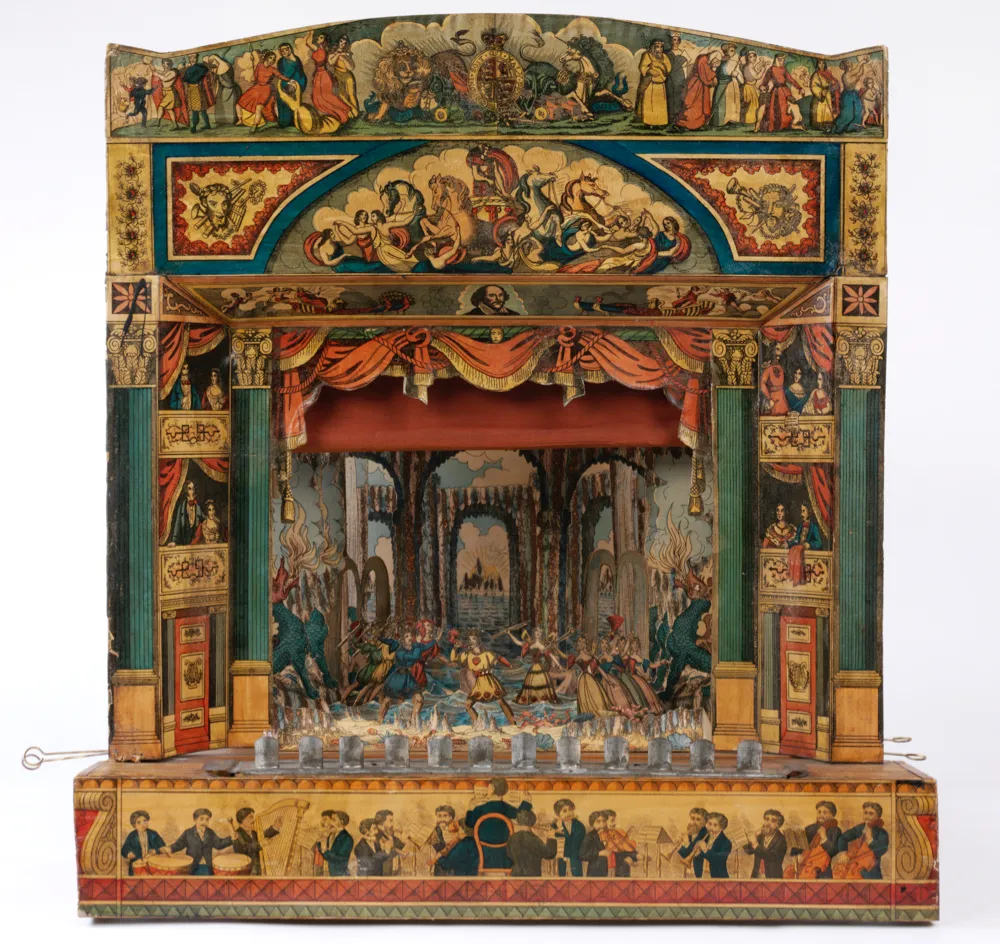One Christmas many years ago I bought a Pollock’s toy theatre with the yearly cheque I received from a kind godfather.
You can imagine my excitement as the jaunty Harrods delivery van bounced up our rickety gravel drive. I must have been about ten years old. That Christmas my family was forced to watch several creaky performances of Jack the Giant Killer with my long suffering little sister dragooned into reading the minor parts.
Later, as an undergraduate at London University, I discovered Pollock’s shop in a dingy back street off Tottenham Court Road. I was drawn in like a moth to candle and it became a regular haunt, as much because of its dusty and intoxicatingly archaic atmosphere that evoked the long-forgotten gas-lit ambience of Edwardian streets, as the stock itself.

Toy theatres were popular childrens' toys until their decline at the end of the 19th century. Miniature stages, prosceniums (the area around the theatre stage), characters, scenery and props were printed onto paper from copper plates and sold by publishers and stationers as individual sheets. You could buy 'a Penny Plain, or a Tuppence Coloured'. These could be cut out, pasted onto card or wood and then painted - if the child had decided to plump for the cheaper, uncoloured option.
From Victorian melodramas to pantomimes and historical romances, children had a wide range of plays to choose from. The 'actors' were mounted onto little tin slides and were pushed onto the stage from the side wings. Sometimes, a play might include exciting stage tricks and effects as in The Miller and his Men (1835), which included moving water and, disturbingly, rather realistic explosions.
We can trace the early days of the English toy theatre to the Regency period, when William West set up shop in Exeter Street, Covent Garden. By the 1880s, however, just two toy theatre publishers remained in London: Pollock in Hoxton and Webb in Finsbury. Only Benjamin Pollock’s shop struggled on as a quaint anachronism until its owner's death in the 1930s.

Part of the decline of English toy theatres resulted from the arrival of imported theatres from Germany and Denmark. If the populist charm of English toy theatre had been enjoyed by children from a wider background, European theatres were more the preserve of children of the upper and upper middle class families and were altogether grander and more sophisticated affairs. They had magnificent prosceniums, sumptuous chromolithographic colour printing and even operatic productions such as The Magic Flute.
In 1944, Alan Keen, a raffish advertising man turned rare book dealer, bought up the entire stock of Pollock’s old shop (including the original copper printing plates) and began republishing the plays and theatres. An interesting play from this period is Laurence Olivier’s Hamlet, 'reproduced from the J. Arthur Rank Enterprise' and published for the miniature stage in 1948. It featured colour-tinted photographic cutouts of a swashbuckling Sir Laurence, with scenery and costumes taken directly from the film’s original set designs by Roger Furse.
Six years later, facing bankruptcy, the business was saved by the remarkable Marguerite Fawdry, who re-established Pollock’s in the attic of an old house in Monmouth Street, Covent Garden, with the additional lure of a fascinating toy museum, which soon became a mecca for trendy parents searching for quirky presents for their children in swinging sixties London. Pollock's museum has now moved to Scala Street, Fitzrovia, where you can visit it today.
Bakelite-mounted Pollock’s theatres from the late 1940s turn up at auction on a regular basis, and can be bought for £100 or less. Despite their rarity, 19th century theatres are still affordable and, if you’re lucky, charming late 19th century theatres can be found in the region of £400-600 at auction, rising to £1,000 for the scarcest examples. Facsimile prosceniums, scenery, characters and plays, reprinted by enthusiasts from the original antique sheets, are available on eBay for under £100.
You can see further examples of toy theatres at both Pollock's Toy Museum, 1 Scala Street, London W1T 2HL and on the mezzanine level of the V&A Museum of Childhood, Cambridge Heath Rd, London E2 9PA
